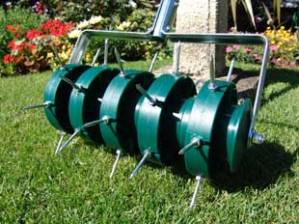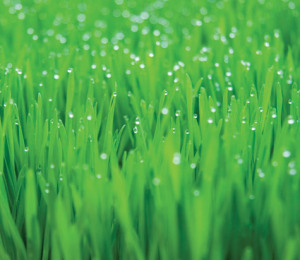If you’ve looked in your mail recently, you’ve bound to come across at least one pamphlet or brochure of a company advertising their lawn and garden maintenance packages. You may know the benefits of having your lawn cut and weeded, but do you know there are many other things you can do to further the health of your lawn?
Even if you have seen the terms aerating, top dressing, and overseeding, do you know exactly what they are, and how they can make your lawn look better and be healthier?
Let’s go over the most common ways to care for your lawn, and give a brief overview of how they can help:
Aerating – The first thing that should be done in spring is to aerate your lawn. Using a garden tool  called an aerator, small holes are created either by pulling out a “plug” of soil or by pushing the soil aside with a spike. Using a core/plug aerator is often more effective as there is no soil compaction surrounding the hole, which in turn allows it to remain open longer (compacted soil allows water to pool; expanding the soil and closing up the hole again).
called an aerator, small holes are created either by pulling out a “plug” of soil or by pushing the soil aside with a spike. Using a core/plug aerator is often more effective as there is no soil compaction surrounding the hole, which in turn allows it to remain open longer (compacted soil allows water to pool; expanding the soil and closing up the hole again).
There are several reasons why you would want to aerate your soil. Firstly, it allows air and water to penetrate deeper into the soil making deeper, healthier roots grow. If followed by top dressing, it also allows nutrients to reach the root system more effectively. By aerating, you also break up the thatch; the layer of stems (both living and dead), leaves, and roots that builds up between the actively growing grass and the soil beneath. Though thatch is a natural part of a healthy lawn, if allowed to build up too thick it can become a barrier that stops water, nutrients and air to flow through to the roots. A thick layer of thatch can also become a haven for pests and diseases.
In addition to allowing a better flow through to the root system, aerating also has the benefit of removing unwanted pests like grubs. Once the soil is no longer compacted, beetles are less likely to lay their eggs as they prefer undisturbed soil. If you do have beetles grubs in your lawn, the physical act of aerating can kill off many of them as they are most commonly found 1/2 inch to 2 1/2 inches below the ground – within the reach of the aerating cores or spikes!
Deep, healthy, roots are the cornerstone of every healthy lawn, and aeration is the first step to achieving that!
Top Dressing – This may may be one of the terms most commonly used by professionals, and it simply means covering the lawn with an extra layer of topsoil. What is not simple however, is to find the right balance of loam, peat moss, and compost for your lawn. This step is important for replacing nutrients that wash away or are lost over the course of a season and improve existing soil conditions.
This is most effective if done soon after aerating to allow nutrients to flow directly to the root system.
Overseeding – This can be done directly after the top dressing has been applied, and on top of soil that has been loosened either through aerating or heavy raking. This is done either in autumn, or in spring if there is winter damage.
Overseeding is important to promote a healthy, lush lawn. Over time, grass plants decrease in production and if left unchecked, can result in a  thin and unhealthy lawn that is susceptible to weeds.
thin and unhealthy lawn that is susceptible to weeds.
Overseeding is also a great opportunity to introduce more drought tolerant grass types. As technology improves there are many types of grasses specifically designed to required less watering and even coated seeds that retain water before they sprout. Not only is this great for your water bill, but also helps reduce water consumption and waste!
Fertilizing – If top dressing is applied each year, fertilizing can be done less often and still maintain the overall health of your lawn (many nutrients are contained in the compost portion of the top dressing). However, if your grass is in a high traffic area, or if you are trying to heal a thin and unhealthy lawn, then extra fertilizer is highly recommended.
Nitrogen is the most important nutrient for grass, yet if applied incorrectly it can burn and harm the plants. Extra care must be taken in application, professionals are commonly used for this step.
In addition to the above, most people are familiar with the watering and mowing necessary to keep your lawn healthy and looking good. Yet even these can be done incorrectly!
Mowing – The biggest mistake people make is cutting their lawn too short, and infrequently. The grass must be cut no shorter than three inches; this provides shade for the roots and helps to out-grow weeds. It is also best of the grass is not cut more than 1/3 of the shoot length at a time – mow more frequently at a higher setting. Also important is to leave the grass cuttings on the lawn: this returns much-needed nitrogen back into the soil naturally. (Many people do not like the look of grass cuttings left on the lawn, but they are simply letting the grass grow too long before mowing. Doing so more regularly will leave less mess behind!)
Watering – Most people over-water their lawns, but when they do, they do not water deep enough. A healthy lawn should need to be watered less than once a week, and before 10 a.m. to avoid evaporation, Water deeply; at least 2.5 cm (or 1 inch); grass that is not watered deeply enough will develop shallow and unhealthy root systems.
Check for insects/pests/weeds – On a regular basis, manually check the lawn for signs of insects (grubs, beetles, etc.), pests (moles) or weeds. Pull unwanted plants and apply insect and pest management techniques as needed. See our post regarding grub and Japanese Beetle control using nematodes!
For more information, you can check out the Ontario Ministry of Agriculture and Food’s lawn maintenance fact sheet.
All this may seem tedious and a little bit daunting, especially when you want to spend your time enjoying your lush, green lawn and not constantly worrying about maintaining it. If that is the case, your local lawn and garden professionals can give you a hand.
Budget and schedule depending you may opt for a one-time service, or for a full-season program to keep your lawn looking it’s best. And don’t forget to call your friendly Harbourview Property Management team for a free quote today!
